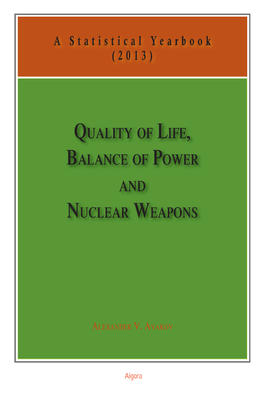
Sound Bite
Who has the most nuclear assets in the Middle East? Whose power is waning, whose increasing? Updated annually, these economic, demographic and military indicators establish the pecking order for 232 countries, with estimates of all nuclear arsenals including rarely published data on non-signatory nations.
About the Author
Alexander V. Avakov was born in the USSR. Interested in economic statistics since childhood, he accomplished his formal university education in mathematics and mathematical economics with additional studies in economics, philosophy, law, politics, anthropology, sociology and psychology.
As a result of early political maturity he was arrested in 1975 for distributing liberal-minded leaflets at the university. Sentenced to a year and half of hard labor, he was sent to a KGB-run camp for political prisoners. After completing the prison term, he emigrated from the Soviet Union and has since settled with his family in the United States.
Mr. Avakov has published several books with Algora, including Plato’s Dream Realized: Surveillance and Citizen Rights, from KGB to FBI, and a variety of statistical studies analyzing the relative power of nations in terms both economic and military, including undeclared nuclear weapons. Previously published books in Russian include, among others, Autobiography of the Soviet Anti-Soviet Philosopher, and Welcome to the New Security State.
|
|
About the Book
This statistical annual presents fundamental data in three sections: (1) Quality of Life, (2) Balance of Power, and (3) Developed Market Economies since 1960. It contains data that is generally not available elsewhere, such as estimates on nuclear...
This statistical annual presents fundamental data in three sections: (1) Quality of Life, (2) Balance of Power, and (3) Developed Market Economies since 1960. It contains data that is generally not available elsewhere, such as estimates on nuclear delivery systems and the number of nuclear warheads of all nuclear powers. This is based on information from reputable sources. Among others, it includes estimates of the Israeli nuclear arsenal which usually do not appear in the press.
Official estimates of Russian military expenditures distributed by US and British intelligence communities are methodologically flawed. Such estimates claim to give a picture of military expenditures of the countries of the world at market exchange rates; at the same time, they apparently cite Russian military expense figures at purchasing power parities, thus inflating these numbers in comparison to those of other countries. Such deceptive practices of the Anglo-American intelligence services are counter-balanced by presenting two different tables, showing military expenditures estimates both at market exchange rates and by purchasing power parities.
Section 3 gives data on the topic of health care. It seems that public health expenditures as a share of total health expenditures has a stronger correlation with the comparative level (and the rates of improvement) of the main health care indicators than the absolute level (measured as a percent of GDP) of total health expenditures. The data demonstrates that the US has the lowest public health expenditure of developed market economies and is increasingly lagging behind other countries by main health care indicators.
The introduction of national health insurance in the US will probably mean some sort of tax increase. The author therefore also seeks to shed light on modern ideological debates about the share of taxation in GDP and its influence on rates of growth. Surprisingly enough, the empirical data for the developed market economies do not seem to support the popular idea that low taxes are strongly correlated with higher rates of growth; depending on how the data are analyzed, the appropriate correlations are either low or even the reverse of what is commonly believed.
|
|
Pages 172
Year: 2013
BISAC: REF027000
BISAC: POL018000
BISAC: POL001000
Soft Cover
ISBN: 978-0-87586-963-6
Price: USD 19.95
Hard Cover
ISBN: 978-0-87586-964-3
Price: USD 29.95
eBook
ISBN: 978-0-87586-965-0
Price: USD 19.95
|













